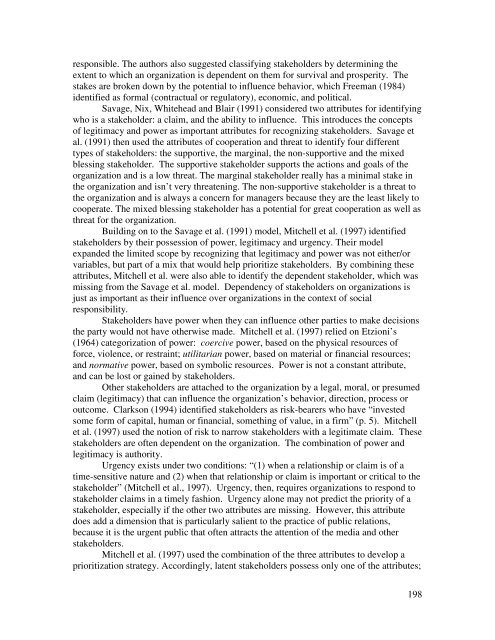2010 - Public Relations Society of America
2010 - Public Relations Society of America
2010 - Public Relations Society of America
You also want an ePaper? Increase the reach of your titles
YUMPU automatically turns print PDFs into web optimized ePapers that Google loves.
esponsible. The authors also suggested classifying stakeholders by determining the<br />
extent to which an organization is dependent on them for survival and prosperity. The<br />
stakes are broken down by the potential to influence behavior, which Freeman (1984)<br />
identified as formal (contractual or regulatory), economic, and political.<br />
Savage, Nix, Whitehead and Blair (1991) considered two attributes for identifying<br />
who is a stakeholder: a claim, and the ability to influence. This introduces the concepts<br />
<strong>of</strong> legitimacy and power as important attributes for recognizing stakeholders. Savage et<br />
al. (1991) then used the attributes <strong>of</strong> cooperation and threat to identify four different<br />
types <strong>of</strong> stakeholders: the supportive, the marginal, the non-supportive and the mixed<br />
blessing stakeholder. The supportive stakeholder supports the actions and goals <strong>of</strong> the<br />
organization and is a low threat. The marginal stakeholder really has a minimal stake in<br />
the organization and isn’t very threatening. The non-supportive stakeholder is a threat to<br />
the organization and is always a concern for managers because they are the least likely to<br />
cooperate. The mixed blessing stakeholder has a potential for great cooperation as well as<br />
threat for the organization.<br />
Building on to the Savage et al. (1991) model, Mitchell et al. (1997) identified<br />
stakeholders by their possession <strong>of</strong> power, legitimacy and urgency. Their model<br />
expanded the limited scope by recognizing that legitimacy and power was not either/or<br />
variables, but part <strong>of</strong> a mix that would help prioritize stakeholders. By combining these<br />
attributes, Mitchell et al. were also able to identify the dependent stakeholder, which was<br />
missing from the Savage et al. model. Dependency <strong>of</strong> stakeholders on organizations is<br />
just as important as their influence over organizations in the context <strong>of</strong> social<br />
responsibility.<br />
Stakeholders have power when they can influence other parties to make decisions<br />
the party would not have otherwise made. Mitchell et al. (1997) relied on Etzioni’s<br />
(1964) categorization <strong>of</strong> power: coercive power, based on the physical resources <strong>of</strong><br />
force, violence, or restraint; utilitarian power, based on material or financial resources;<br />
and normative power, based on symbolic resources. Power is not a constant attribute,<br />
and can be lost or gained by stakeholders.<br />
Other stakeholders are attached to the organization by a legal, moral, or presumed<br />
claim (legitimacy) that can influence the organization’s behavior, direction, process or<br />
outcome. Clarkson (1994) identified stakeholders as risk-bearers who have “invested<br />
some form <strong>of</strong> capital, human or financial, something <strong>of</strong> value, in a firm” (p. 5). Mitchell<br />
et al. (1997) used the notion <strong>of</strong> risk to narrow stakeholders with a legitimate claim. These<br />
stakeholders are <strong>of</strong>ten dependent on the organization. The combination <strong>of</strong> power and<br />
legitimacy is authority.<br />
Urgency exists under two conditions: “(1) when a relationship or claim is <strong>of</strong> a<br />
time-sensitive nature and (2) when that relationship or claim is important or critical to the<br />
stakeholder” (Mitchell et al., 1997). Urgency, then, requires organizations to respond to<br />
stakeholder claims in a timely fashion. Urgency alone may not predict the priority <strong>of</strong> a<br />
stakeholder, especially if the other two attributes are missing. However, this attribute<br />
does add a dimension that is particularly salient to the practice <strong>of</strong> public relations,<br />
because it is the urgent public that <strong>of</strong>ten attracts the attention <strong>of</strong> the media and other<br />
stakeholders.<br />
Mitchell et al. (1997) used the combination <strong>of</strong> the three attributes to develop a<br />
prioritization strategy. Accordingly, latent stakeholders possess only one <strong>of</strong> the attributes;<br />
198
















